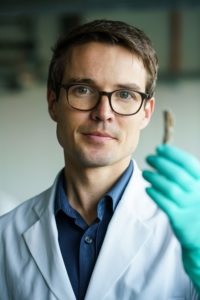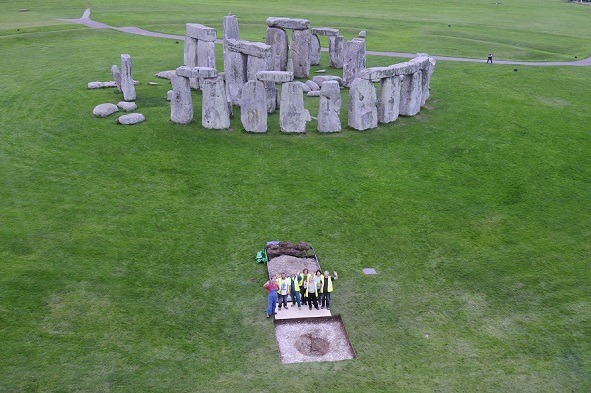It is possibly the most architecturally sophisticated prehistoric stone circle in the world. But while it is one of the world's most famous monuments, the prehistoric stone circle known as Stonehenge in south west England remains shrouded in mystery.
That is, until now. Thanks to state-of-the-art research pioneered and led by Belgian academic Christophe Snoeck, we now know rather more about the mysteries of Stonehenge. He returned to work in his native Belgium after completing his PhD in archaeological science in 2015 at Oxford University. His research suggests that a number of the people that were buried at the Wessex site had moved with and likely transported the bluestones used in the early stages of the monument's construction, sourced from the Preseli Mountains of west Wales.
While there has been much speculation as to how and why the iconic collection of stones was built, the question of who built it has received far less attention. That is where Dr Snoeck, still aged just 32 and based at Vrije Universiteit Brussel (VUB), comes in. His innovative research has made it finally possible to extract information about the geographical origin of cremated individuals. In partnership with colleagues at the Muséum National d'Histoire Naturelle de Paris and University College London, he led the Stonehenge research, which combined radiocarbon-dating with new developments in archaeological analysis.
Dr Snoeck, who pioneered the techniques during his doctoral research, said the discovery that some biological information survives the high temperatures reached during cremation (up to 1,000 degrees Celsius), offers the “exciting possibility” to finally study the origin of those buried at Stonehenge.
In an interview with The Brussels Times, he explained how his team went about their work and the significance of their findings. The Antwerp-born researcher said, “Stonehenge is one of the most iconic archaeological sites in the world, and when I had the opportunity to carry out research on the site it was an immense privilege. Before we started our study, we knew, from previous work, that the bluestones used to build the earlier phases of the monument came from west Wales. By working directly on the human remains found at the site we hoped to gain insight, not on the origin of the stones, but on the origin of those using the site and being buried there.”
The work involved analysis of small fragments of cremated human bone from an early phase of the site's history around 3000 BC, when it was mainly used as a cemetery. “Most research on Stonehenge focused on the stones,” he explains. “Little was known about the humans buried at the site. This is mostly due to the fact that they were cremated and only small cremated bone fragments remained. It is only very recently that new methods have been developed to study cremated human remains.”
During his doctoral research he developed a method to extract information about the geographical origin of cremated individuals. This method, he says, “was applied to 25 cremated individuals from Stonehenge and our results show that 40% (10 out of 25 analysed individuals) did not live near Stonehenge in the last decade or so prior to their deaths but came from further away. Some might actually have originated from west Wales where the bluestones came from, some 250km away,” he adds. “This shows the importance of the site in the British landscape during the Neolithic period.”

Photo of Carn Goedog in western Wales. The dolerite bluestones from these hills are thought by many geologists and archaeologists to be the source of several of the stones erected in the early stage of Stonehenge’s construction with dates of quarrying around 5,000 years ago. © Adam Stanford
His personal contribution to the study was mostly in the scientific analyses including isotope, elemental and infrared analyses. The results were then discussed and interpreted with the rest of the team. But the challenges of handling tiny fragments of burnt bone should not be overlooked. “Working on cremated bone fragments can be very tricky as they are very little and brittle. However, with proper care, we were able to carry out all the analyses planned.”
Understanding the past
So, why does all this matter? Well, according to Dr Snoeck, the results emphasise the importance of inter-regional connections involving the movement of both materials and people in the construction and use of Stonehenge. This, in turns, provides rare insight into the large scale of contacts and exchanges in the Neolithic era, as early as 5000 years ago.

Dr Snoeck
Dr Snoeck, who specializes in archaeology and chemistry, says it us crucial to understand the lives of past animal and human populations, including diet, mobility, landscape use and environmental conditions. The techniques used on the Stonehenge project could be used, he hopes, to improve our understanding of the past.
He said, “Understanding our past is, to me, of crucial importance to better understand where we are now and how we reached this stage. I think both Stonehenge and the pyramids of Egypt (and many more sites) are fascinating. They are markers of our past and unravelling the mysteries around their construction and use is definitely helping us better understand our past. The importance of archaeological sites cannot really be classified in my opinion.”
On the importance of learning more about people from the Neolithic period, he said, “By gathering more information about them, we can start to understand the place of such sites in the wider landscape and how they shaped societies and beliefs through time and space. We were very excited to see that not all individuals lived near the site and that many actually moved over quite large distances to come to Stonehenge. Clearly we are not going to cure disease with this but understanding how people and societies changed trough time and space helps us understand current societies and how they might change and interact.”
The results of his work were published in Scientific Reports in 2018 and have received global media attention with news reports in more than 100 Belgian outlets (incl. Radio 2, Het Laatste Nieuws, Het Nieuwsblad, De Morgen, EOS Wetenschap, Le Soir) and international media (BBC, Guardian, CNN, National Geographic, Current Archaeology and the Washington Post).
Following this ground-breaking study, he has been nominated as one of the three candidates for the Archaeologist of the Year 2019 Award by the British magazine Current Archaeology. For him and many others there is an enduring fascination with Stonehenge that will continue. The reason? “Well, it is still there after 5000 years! And there is still so much we don't know. Mysteries are fascinating,” says Dr Snoeck.
His archaeological work does not end with Stonehenge, and he is now engaged on a project on the famous Belgian iguanodon collection (a genus of dinosaurs) at the Royal Belgian Institute of Natural Science. “The aim of this work is to better understand why so many Iguanodons were found at Bernissart in Hainaut. The research is still in progress.” Christophe Snoeck also plans to study cremated remains in other countries. “They've been kind of forgotten and put aside. And I thought that was quite sad, because in huge parts of the world, especially in prehistoric Europe, people were cremated.”
By Martin Banks

